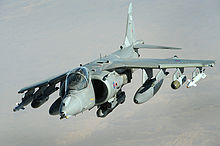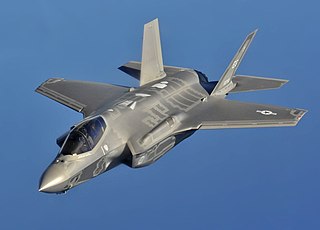
The Lockheed Martin F-35 Lightning II is an American family of single-seat, single-engine, all-weather stealth multirole combat aircraft that is intended to perform both air superiority and strike missions. It is also able to provide electronic warfare and intelligence, surveillance, and reconnaissance capabilities. Lockheed Martin is the prime F-35 contractor, with principal partners Northrop Grumman and BAE Systems. The aircraft has three main variants: the conventional takeoff and landing (CTOL) F-35A, the short take-off and vertical-landing (STOVL) F-35B, and the carrier-based (CV/CATOBAR) F-35C.

The Fleet Air Arm (FAA) is the naval aviation component of the United Kingdom's Royal Navy (RN). The FAA is one of five RN fighting arms. As of 2023 it is a predominantly "rotary" force, with helicopters undertaking roles once performed by biplanes such as the Fairey Swordfish. It operates the F-35 Lightning II for maritime strike and the AW159 Wildcat and AW101 Merlin for commando and anti-submarine warfare.

The Harrier, informally referred to as the Harrier jump jet, is a family of jet-powered attack aircraft capable of vertical/short takeoff and landing operations (V/STOL). Named after a bird of prey, it was originally developed by British manufacturer Hawker Siddeley in the 1960s. The Harrier emerged as the only truly successful V/STOL design of the many attempted during that era. It was conceived to operate from improvised bases, such as car parks or forest clearings, without requiring large and vulnerable air bases. Later, the design was adapted for use from aircraft carriers.

The Lockheed Martin X-35 is a concept demonstrator aircraft (CDA) developed by Lockheed Martin for the Joint Strike Fighter program. The X-35 was declared the winner over the competing Boeing X-32 and a developed, armed version went on to enter production in the early 21st century as the F-35 Lightning II.

The Queen Elizabeth-class aircraft carriers of the United Kingdom's Royal Navy consists of two vessels. The lead ship of her class, HMS Queen Elizabeth, was named on 4 July 2014 in honour of Elizabeth I and was commissioned on 7 December 2017. Her sister ship, HMS Prince of Wales, was launched on 21 December 2017, and was commissioned on 10 December 2019. They form the central components of the UK Carrier Strike Group.

HMS Queen Elizabeth is the lead ship of the Queen Elizabeth class of aircraft carriers and the Fleet Flagship of the Royal Navy. Capable of carrying 60 aircraft including fixed wing, rotary wing and autonomous vehicles, she is named in honour of the first HMS Queen Elizabeth, a World War I era super-dreadnought, which in turn was named after Queen Elizabeth I. The carrier Queen Elizabeth carries her namesake ship's honours, as well as her Tudor rose-adorned crest and motto.

Future planning of the Royal Navy's capabilities is set through periodic Defence Reviews carried out by the British Government. The Royal Navy's role in the 2020s, and beyond, is outlined in the 2021 defence white paper, which was published on 22 March 2021. The white paper is one component of the Integrated Review of Security, Defence, Development and Foreign Policy, titled as Global Britain in a Competitive Age which was published on 16 March 2021.

Joint Force Harrier, initially known as Joint Force 2000 and towards the end of its life as Joint Strike Wing, was the British military formation which controlled the British Aerospace Harrier II and British Aerospace Sea Harrier aircraft of the Royal Air Force and Fleet Air Arm between 2000 and 2011. It was subordinate to RAF Air Command.
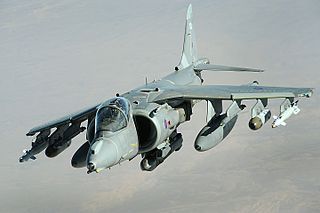
The British Aerospace Harrier II is a second-generation vertical/short takeoff and landing (V/STOL) jet aircraft used previously by the Royal Air Force (RAF) and, between 2006 and 2010, the Royal Navy (RN). The aircraft was the latest development of the Harrier family, and was derived from the McDonnell Douglas AV-8B Harrier II. Initial deliveries of the Harrier II were designated in service as Harrier GR5; subsequently upgraded airframes were redesignated accordingly as GR7 and GR9.

The Eurofighter Typhoon is in service with nine nations: United Kingdom, Germany, Italy, Spain, Saudi Arabia, Oman, Qatar, Kuwait, and Austria, with orders for all nine customers still pending as of September 2017. The aircraft has, as of 2016, been provided in a basic air-defense form and has been upgraded to newer production standards which include internal IRST, air-to-ground precision strike capability, and HMSS helmets. Most of the major systems including the CAPTOR radar and the Defence Aids Sub-System (DASS) are expected to be improved and updated over time, with the radar being updated to an AESA, being the CAPTOR-E/CAESAR, of which the Kuwait Air Force will be the inaugural operator, with first deliveries of their 28 new-built aircraft to commence in 2019.

Joint Strike Fighter (JSF) is a development and acquisition program intended to replace a wide range of existing fighter, strike, and ground attack aircraft for the United States, the United Kingdom, Italy, Canada, Australia, the Netherlands, Denmark, Norway, and formerly Turkey. After a competition between the Boeing X-32 and the Lockheed Martin X-35, a final design was chosen based on the X-35. This is the F-35 Lightning II, which will replace various tactical aircraft, including the US F-16, A-10, F/A-18A-D, AV-8B, EA-6B and British Harrier GR7, GR9s and Tornado GR4. The projected average annual cost of the program is $12.5 billion with an estimated program life-cycle cost of $1.1 trillion.
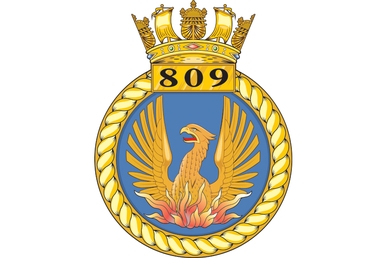
809 Naval Air Squadron is a squadron of the Fleet Air Arm of the United Kingdom. It was first formed in 1941 and flew in the Soviet Union, the Mediterranean and the Far East during the Second World War.In Jan 54 the sqdn equipt with Sea Hornet NF21s joined HMS Eagle enroute to the Med, however when an a/c was lost over the ships side the sqdn was put ashore in Gibraltar to operate from North Front airfield, the sqdn personnel were embarked on another carrier on way back to the UK the a/c having flown back to UK at this time. The sqdn was disbanded at Culdrose and moved to Yeovilton and took delivery of Venom 20s later updated to 21s, in Nov 55 moved to Malta operating from RAF Takali as Halfar was undergoing runway refurbishment. After active service during the Suez Crisis, 809 was disbanded in 1959. Reformed in 1963 to fly Blackburn Buccaneers, the squadron was disbanded briefly in 1965-66, and then again in 1978. A brief period during the Falklands War saw 809 reformed to bring Sea Harrier FRS.1 aircraft south to the UK task group and to fly from HMS Illustrious.
The planning for the future of the Royal Air Force involves supporting ongoing British military operations, the introduction of new aircraft types including unmanned aerial vehicles, greater focus on network enabled capability and increasing interoperability with members of NATO, team tempest, and mixed crewed fighters. From the updated plans of the RAF (2021) state that the new initiative will focus on becoming carbon net-zero, with strategies such as using sustainable aviation fuels in aircraft. The RAF also are looking into investing in the maintenance of the aircraft to ensure success of future operations.

The Rolls-Royce LiftSystem, together with the F135 engine, is an aircraft propulsion system designed for use in the STOVL variant of the F-35 Lightning II. The complete system, known as the Integrated Lift Fan Propulsion System (ILFPS), was awarded the Collier Trophy in 2001.
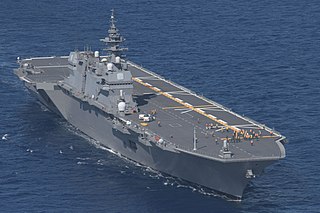
The Izumo-class destroyers are helicopter destroyers in service with the Japan Maritime Self-Defense Force (JMSDF). The official classification of these ships is DDH, which is accepted by the United States Naval Institute; in contrast, Jane's Fighting Ships describes this official classification, but the classification is simply "helicopter carrier".

Lockheed Martin F-35 Lightning II procurement is the planned selection and purchase of the Lockheed Martin F-35 Lightning II, also known as the Joint Strike Fighter (JSF) by various countries.

The Lightning Force HQ was the organisation controlling the operations of the Lockheed Martin F-35B Lightning aircraft of the Fleet Air Arm and Royal Air Force. Following on from the principles developed in the operation of the UK's previous STOVL aircraft, the Harrier, the formation is a joint organisation falling under RAF Air Command.

Arthur Tomassetti is a retired United States Marine Corps colonel, combat veteran, and test pilot who is notable for his work on the Joint Strike Fighter (JSF) and F‑35 Lightning II. During twenty-one years on the programs, he worked in key roles developing pilot interfaces, testing aircraft capabilities, fielding aircraft to operational units, and establishing the F-35 training organization that certifies US and international pilots and maintainers.

The UK Carrier Strike Group (UKCSG) is a carrier battle group of the Royal Navy. It has existed in various forms since the mid-2000s. Between 2006 and 2011, the formation centred around the Royal Navy's Invincible-class aircraft carriers until the retirement of their Harrier GR9 strike aircraft in 2011 as a result of the Strategic Defence and Security Review. The UKCSG subsequently returned in February 2015 ahead of the entry into service of the new Queen Elizabeth-class aircraft carriers, HMS Queen Elizabeth and HMS Prince of Wales. The aim of the CSG is to facilitate carrier-enabled power projection.

The United Kingdom Carrier Strike Group 21 (CSG21) was a British-led naval force that was deployed on Operation Fortis from May to December 2021. The Carrier Strike Group is seen as the beginning of the British Government's tilt towards the Indo-Pacific region in terms of defence and foreign policy, that had been announced in March through the Integrated Review. It was the first strike group deployment for the Queen Elizabeth-class aircraft carriers, and the first operational deployment of the UK Carrier Strike Group since 2011. The deployment was the largest single deployment of F-35 fighter aircraft since the programme started in 2006, and the largest fifth-generation fighter carrier air wing in the world at the time. Furthermore, HMS Queen Elizabeth saw the largest number of personnel embarked since she entered service, and the group contained the largest number of Royal Navy maritime helicopters deployed in over 10 years.


